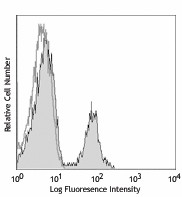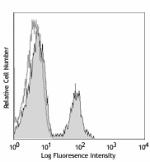- Clone
- 3F3 (See other available formats)
- Regulatory Status
- RUO
- Workshop
- VI CD72.1
- Other Names
- Lyb-2, Ly-19.2, Ly-32.2
- Isotype
- Mouse IgG2b, κ

-

Human peripheral blood lymphocytes stained with 3F3 FITC
| Cat # | Size | Price | Quantity Check Availability | ||
|---|---|---|---|---|---|
| 316203 | 25 tests | $101.00 | |||
| 316204 | 100 tests | $229.00 | |||
CD72 is a 39-43 kD type II membrane glycoprotein. It is a disulfide-linked homodimer belonging to C-type lectin family. CD72 is a pan-B cell marker expressed on pre-pre-B cells throughout B cell differentiation with the exception of plasma cells. It is also expressed on follicular dendritic cells, splenic red pulp macrophages (but not on peripheral blood monocytes), and liver Kupffer cells. CD72, a negative coreceptor of B cells, contains immunoreceptor tyrosine-based inhibitory motifs in the cytoplasmic domain which has been shown to recruit the tyrosine phosphatase SHP-1. Ligation of CD72 with its ligand regulates CD72 tyrosine dephosphorylation and SHP-1 dissociation to promote B cell activation and proliferation. CD100 and CD5 have been shown to be CD72 ligands. The CD100-CD72 interaction plays a role in maintenance of B cell homeostasis.
Product Details
- Verified Reactivity
- Human
- Antibody Type
- Monoclonal
- Host Species
- Mouse
- Immunogen
- Human lymphocytes
- Formulation
- Phosphate-buffered solution, pH 7.2, containing 0.09% sodium azide and BSA (origin USA)
- Preparation
- The antibody was purified by affinity chromatography, and conjugated with FITC under optimal conditions.
- Concentration
- Lot-specific (to obtain lot-specific concentration and expiration, please enter the lot number in our Certificate of Analysis online tool.)
- Storage & Handling
- The antibody solution should be stored undiluted between 2°C and 8°C, and protected from prolonged exposure to light. Do not freeze.
- Application
-
FC - Quality tested
- Recommended Usage
-
Each lot of this antibody is quality control tested by immunofluorescent staining with flow cytometric analysis. For flow cytometric staining, the suggested use of this reagent is 5 µl per million cells in 100 µl staining volume or 5 µl per 100 µl of whole blood.
- Excitation Laser
-
Blue Laser (488 nm)
- Application Notes
-
Additional reported applications (for the relevant formats) include: immunoprecipitation.
-
Application References
(PubMed link indicates BioLegend citation) -
- Knapp W, et al. Eds. 1989. Leucocyte Typing IV. Oxford University Press. New York.
- RRID
-
AB_2291346 (BioLegend Cat. No. 316203)
AB_2291346 (BioLegend Cat. No. 316204)
Antigen Details
- Structure
- Type II membrane glycoprotein, C-type lectin family, 39-43 kD, homodimer
- Distribution
-
Pre-pre-B cells throughout B cells differentiation (but not on plasma cells), follicular dendritic cells, splenic red pulp macrophages, liver Kupffer cells
- Function
- negative regulation of B cell receptor signaling
- Ligand/Receptor
- CD5, CD100/Sema4D
- Cell Type
- B cells, Dendritic cells
- Biology Area
- Immunology
- Molecular Family
- CD Molecules
- Antigen References
-
- Knapp W, et al. Eds. 1989. Leucocyte Typing IV. Oxford University Press. New York.
- Schwarting T, et al. 1992. Am. J. Hematol. 41:151.
- Wu HJ and S. Bondata. 2002. Immunol. Res. 25:155.
- Kumanogoh A, et al. 2000. Immunity 13:621.
- Parnes JR and C. Pan. 2000. Immunol. Rev. 176:75.
- Kumanogoh A, et al. 2005. Intnl. Immunol. 17:1277.
- Gene ID
- 971 View all products for this Gene ID
- UniProt
- View information about CD72 on UniProt.org
Other Formats
View All CD72 Reagents Request Custom Conjugation| Description | Clone | Applications |
|---|---|---|
| Purified anti-human CD72 | 3F3 | FC,IP |
| FITC anti-human CD72 | 3F3 | FC |
| TotalSeq™-A0419 anti-human CD72 | 3F3 | PG |
| APC anti-human CD72 | 3F3 | FC |
| PE anti-human CD72 | 3F3 | FC |
| TotalSeq™-C0419 anti-human CD72 | 3F3 | PG |
| TotalSeq™-B0419 anti-human CD72 Antibody | 3F3 | PG |
| TotalSeq™-D0419 anti-human CD72 | 3F3 | PG |
| Pacific Blue™ anti-human CD72 | 3F3 | FC |
Compare Data Across All Formats
This data display is provided for general comparisons between formats.
Your actual data may vary due to variations in samples, target cells, instruments and their settings, staining conditions, and other factors.
If you need assistance with selecting the best format contact our expert technical support team.
-
Purified anti-human CD72

Human peripheral blood lymphocytes stained with purified 3F3... -
FITC anti-human CD72

Human peripheral blood lymphocytes stained with 3F3 FITC -
TotalSeq™-A0419 anti-human CD72
-
APC anti-human CD72

Human peripheral blood lymphocytes were stained with CD19 FI... -
PE anti-human CD72

Human peripheral blood lymphocytes were stained with CD19 FI... -
TotalSeq™-C0419 anti-human CD72
-
TotalSeq™-B0419 anti-human CD72 Antibody
-
TotalSeq™-D0419 anti-human CD72
-
Pacific Blue™ anti-human CD72

Human peripheral blood lymphocytes were stained with anti-hu...
